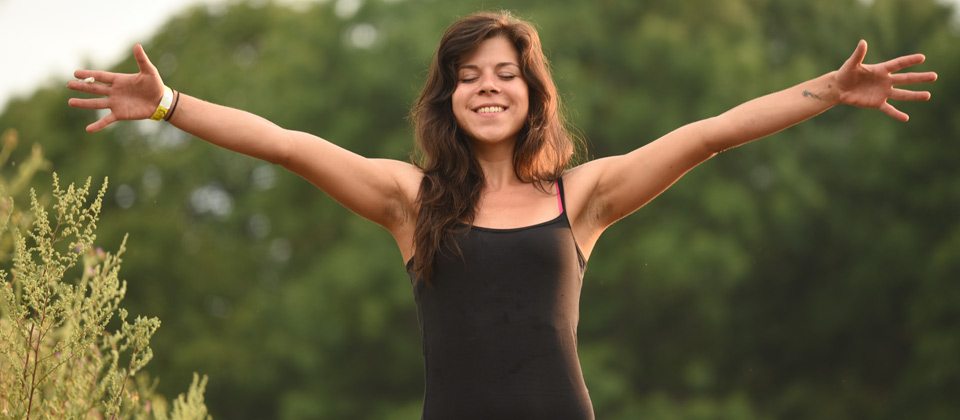
Music and dancing: the oldest ritual feast
Finding rhythm, mirroring the sounds of nature and making music, seemed to be a fundamental human need; a balancing act for the soul. The first ever musical instrument – a flute made from bones – dates 40,000 years. The first ever dance cannot be documented in the same way, but one thing is for sure: where there is rhythm, there is dance.
We know that dance as ritual has accompanied human civilization since its very early days; the cave paintings found in India, dating 9000 years, reveal how our ancestors danced along in ceremony. Dance rituals were associated with all important moments of life: birth, death, harvesting, hunting, healing the sick, giving thanks to the Universe. It was a shared community practice, which allowed some time for the tribe to celebrate and process emotions as one.
Conscious festivals bring the notion of the tribe back to life, as we congregate in small numbers, create social economies and assemble small villages, small communities in nature. Losing ourselves in dance, and finding ourselves again through movement and the power of music, we celebrate existence and human potential with like-minded others. It is a practice that allows us to connect, express, transgress our conditioning, and discover what’s happening inside us and around us.

Ritual dance is an opportunity for the community to come together, to let loose from everyday tasks and pressures and to reconnect as one heartbeat, one interconnected organism that beats together, alongside the sound of the drum. Tribal dance is an opportunity for self-expression in the presence of others, in the space we all co-create as a tribe. Words, our main tool of communication, is suspended and rechannelled into freestyle gestures, allowing for the body to communicate what words have kept hidden. The body can move into whatever form; within its physical limitations, but free of words. It is the time to allow emotion to take over from reason, the time where we can get in touch with the non-verbal, the archetypal, the transcendent. We dance in ceremony, surrounded by others who are going through a similar journey.
Discovery of emotion is our teacher. Any emotion can pass through us like a wave; realising its effect in our bodies, we shift through the beat. We acknowledge the non-permanent in everything, the possibility of change through movement. It is a humbling and empowering experience at the same time: Dancing in nature, we realise yet again that we are just one part of an evolving symmetry; a big fractal that moves as one, changing everything whilst retaining its main substance, the beat of the Cosmos.

In ceremonial environments, like conscious festivals, we find a space where we let go and meet each other in true spirit. We dance freely, surrounded by others, like no-one is watching. Ritual dance it is not a competition: no one is there to impress and stand out. It is not a disco in the forest; it’s the rediscovery of the forest power and what this invokes in us when we dance in communion. It is not an impression management game, as it is when people go for a night out in mainstream night clubs or festivals. We are there to share what it means to be human, what it means to let go of our guard and dance without fear. Without the fear the demands of society have imposed on us, we explore our potential through the waves of sound. As our bodies move, we let go of our egos and find our souls in movement.
Dancing at conscious festivals, we celebrate and we discover. Discover who we are, where we are, what is happening inside all of us. Things that we don’t have time to do when we are running around, completing tasks and worrying about money. Repositioning the oldest ritual in light of technological advancements, this new, techno-shamanism (St John, 2010) is an attempt to get back in touch with our roots, yet without being anachronistic. We rejuvenate the ecstatic ritual that was lost in the Western world since the advent of puritanism and self-restraint, but we bring in the sound of the machine as well. The sounds in psy-trance keep the 4/4 rhythm of the drum, the 4/4 rhythm of the heartbeat, but also brings in all the sounds that our psyche has come across through life in the age of advanced technology. ‘We are modern shamans’, as the Alwoods track reminds us.

Life is about movement, something we forget in our static, predefined lives of the western world. When we put our bodies into movement in safe, ceremonial spaces, we let ourselves to be guided by the beat, by the drum, by the melody loop behind the decks. On the dancefloor, we are alone but not lonely; we are accompanied by fellow travellers who are sharing the space and the same process with us. When we move, things surface, in the form of imagery, thinking, feeling, memory. We realise things that we don’t have usually the time to realise. Rooting ourselves through the beat and the soil, we celebrate in communion.
Self-realisation through co-creative independence is a principle of community. The dancefloor brings this community to life through alternate means of expression. Bringing the ritual back into our lives, we are celebrating life and all that life can be.
